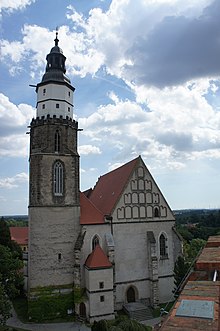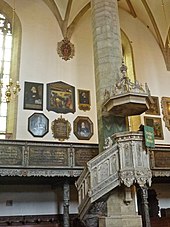St. Marien (Kamenz)
The main Protestant church of St. Marien in Kamenz in the Bautzen district in Saxony is a late Gothic hall church. It belongs to the Evangelical Lutheran Church Community of Kamenz in the regional church of Saxony . It shapes the townscape of Kamenz and was Gotthold Ephraim Lessing's baptistery in 1729 .
Building history
The church of St. Marien had a previous building, the nave of which still existed when today's choir made of granite blocks was built at the end of the 14th century. At the same time as the choir, the sacristy and probably also the tower were built on the north-west corner of the church. The hall church was built after 1430 and vaulted after 1450. Around 1500 the church received the brick gable. In 1793 the tower dome was renewed. In 1887, a restoration was carried out by Gotthilf Ludwig Möckel , who lost valuable items of equipment. In 1908, the galleries were converted by Woldemar Kandler . In 1992, renewed restoration work began.
architecture
The main church St. Marien was built on the highest point of the city and therefore has a special effect on the city skyline . The church is a four-nave, four-bay hall church with a retracted choir, which was built from granite. The three-bay choir ends in a five-eighth closing . The tower is built into the northwest corner of the north aisle and has two Gothic floors above a square basement, the upper one octagonal with figurative gargoyles and a baroque, also octagonal tower end with a hood and lantern .
The interior with the floor rising towards the east shows a generous spatial effect due to the fourth nave. Slender pointed arch windows with rich tracery illuminate the interior. The vaults of the hall church are partly developed from three-ray figures; there are also parallel rib vaults in the central nave and a star vault in the eastern choir bay. Slender octagonal pillars, which merge into the divider arches without a fight , support the vault. Portals on the north sides of the choir and the nave as well as a west portal with rich profiles open up the building. The building is covered with two parallel gable roofs of different heights; the main nave roof is provided to the west with a high gable with a four-tier panel structure, while the roof of the north nave shows a gable with panel structure to the east. The organ loft from 1479 and the council loft from 1480 in the interior are from the Gothic period and have rich star vaults. In the choir there are three celebrant booths with decorative shapes from the Gothic period. A sacrament niche reminiscent of a monstrance with a keel arch frame and a barred door is also still medieval.
The church is surrounded by a cemetery, the wall of which on the side facing away from the city was once part of the city fortifications and where numerous historical grave monuments have been preserved. The catechism church is directly adjacent to the choir of the main church of St. Mary.
Furnishing
The main church St. Marien contains an extremely rich interior from the Gothic and from the post-Reformation period. Of the originally more than 20 altars, two are still preserved at the site of their first installation.
Altars
The main altar from 1519 is a winged altar with rich tendrils and cracks , which shows the larger-than-life representation of Our Lady with the evangelists John and John the Baptist in the shrine. In the predella , the Lord's Supper is depicted in three-dimensional figures. Richly carved canopies crown the figures. The saints Andrew and Christophorus can be found in the wings. There are five figures of saints in a pyramidal arrangement. The alabaster altar crucifix from 1630, which is attributed to the important Dresden Renaissance sculptor Sebastian Walther and comes from a crucifixion group, is remarkable . The corresponding figure of Mary was destroyed in 1945, the figure of Johannes is in the Dresden City Museum .
The Michaelis altar from 1498 is set up as a side altar in the north nave. In the predella he shows saints in half-length representation, Anna Selbdritt in the middle framed by Hubertus and John the Baptist. Michael is depicted in the shrine as a soul weigher. The wings show Apostle Andrew and King Sigismund in two pictures at the top left, including Evangelist John and Pope Gregory; on the right side are shown above Peter and Paul and below Saint Catherine and Barbara.
The sacristy altar from 1620 made of wood and alabaster is on the east wall of the north aisle. It shows a two-storey structure with pillars and the second coming of Christ in the gable .
Liturgical equipment
The baptism in the octagonal cup shape dates from the 14th century. The triumphal cross group from around 1400 was placed back in the triumphal arch after a restoration in 1935 . It shows life-size, high-quality carved figures.
Numerous art treasures from the parish were kept in the sacristy until 2011, including a small reliquary box from around 1380/1400 with two arm reliquaries , a small winged altar from 1505 and a figure of the Christ Child ( Bornkindl ) with a hand raised in blessing and a globe from that time around 1500. These objects are now on loan in the permanent exhibition of the communal Sacral Museum St. Annen ( St. Annen Monastery Church ) in Kamenz.
The pulpit from 1566 is a work by Andreas Dreßler with typologically juxtaposed scenes from the Old and New Testaments. The choir stalls on the north wall of the choir are from 1560. A lectern in the choir was created in 1640 and shows a book-shaped capital on a winding wooden column.
Further equipment
The church houses numerous paintings, panel and votive pictures as well as epitaphs . Of these, a three-part painted epitaph by Cranach's pupil Wolf Krodel from 1543 in the sacristy deserves special mention. The crucified Christ is depicted in the middle panel, the coats of arms of the donors can be found in the corners. The outer panels show representations of judgment and grace; on the left panel death and the devil drive Adam into hell, furthermore Moses is depicted, above it Christ as judge of the world and the fall of man, on the right panel an antithetical depiction of Christ as Redeemer.
An epitaph from 1554, painted by Andreas Dreßler, depicting the Last Judgment is also in the sacristy. A votive picture by the same artist from 1585 depicting an old man and the Assumption in an architectural setting can be seen in the choir. Another altar painting from 1613, depicting the poor widow's mite, was created in 1613 by Christoph Berger from Kamenz and is in the council box.
A large sandstone epitaph was probably created by Zacharias Hegewald in 1627 and is attached to the south wall of the choir. In a three-part structure in the base zone it shows a lettering cartouche with a coat of arms, in the middle field Christ on the cross, flanked by niches with Peter and Paul and the family of the deceased, above the Ascension and God the Father on the globe.
Several prayer rooms and galleries are housed in the nave. Mention should be made of a prayer room on the east wall of the tower from around 1660 and two simultaneous prayer rooms on the north wall with a column and cartilage . The Schumacher choir from 1675 is located on the south side of the nave and shows rectangular fields on the parapet with painted biblical sayings and foliage on a dark gray background.
The Dark Choir from 1675 is located under the organ gallery on the west wall and is painted in a similar way to the Schumacher Choir . The long gallery , a two-storey gallery in brown wood tone, dates from 1703 and 1709. Further two-storey galleries in Gothic-style from 1830 and 1837 are attached to the north wall.
organ
The organ is the work of EF Walcker & Cie. from 1895, which was renovated and rearranged by the Eule organ building company in 1938. After a restoration in 2005 by the Groß company, it has 42 registers on three manuals and pedal and replaced a baroque organ that existed until 1891, which was built by Matthias Schurig in 1682 and contained 36 registers on three manuals and pedal . The Saxon coat of arms on the organ prospectus was retained and is located on the gallery parapet of the Kamenz monastery church .
|
|
|
|
||||||||||||||||||||||||||||||||||||||||||||||||||||||||||||||||||||||||||||||||||||||||||||||||||||
- Pair : I / II, I / III, II / III, P / I, P / II, P / III
- Effect register: Zimbelstern.
- Playing aids: Pleno 1, Pleno 2.
A small positive organ in the choir from 1823 probably came from the Kayser organ building company, the pipework was renewed in 1935 by the Eule company.
Peal
The ringing consists of two chilled cast iron bells and four bronze bells , the bell cage and the bell yokes are made of steel or cast iron. Below is a data overview of the bell:
| No. | Casting date | Caster | material | diameter | Dimensions | Chime |
|---|---|---|---|---|---|---|
| 1 | 1729 | Bell foundry M. Weinhold | bronze | 1407 mm | 1890 kg | it' |
| 2 | 1956 | Bell foundry Schilling & Lattermann | Chilled iron | 1440 mm | 1300 kg | f ′ |
| 3 | 1956 | Bell foundry Schilling & Lattermann | Chilled iron | 1198 mm | 760 kg | as ′ |
| 4th | 1576 | Bell foundry W. Hilliger | bronze | 967 mm | 483 kg | a ′ |
| 5 | 1979 | Bell foundry S. Schilling | bronze | 878 mm | 420 kg | b ′ |
| 6th | 1568 | Bell foundry W. Hilliger | bronze | 1460 mm | 1525 kg | of' |
literature
- Dehio-Handbuch der Deutschen Kunstdenkmäler. Saxony I. District of Dresden. German art publisher. Munich 1996, ISBN 3-422-03043-3 , pp. 465-469.
- Rainer Thümmel : Bells in Saxony . Sound between heaven and earth. Ed .: Evangelical Regional Church Office of Saxony . 2nd, updated and supplemented edition. Evangelische Verlagsanstalt, Leipzig 2015, ISBN 978-3-374-02871-9 , p. 312 (With a foreword by Jochen Bohl and photographs by Klaus-Peter Meißner).
Web links
Individual evidence
- ^ Fritz Löffler: The city churches in Saxony . 4th edition. Evangelische Verlagsanstalt, Berlin 1980, p. 217 .
- ↑ Website of the Kamenz Sacral Museum. Retrieved September 14, 2017 .
- ↑ Information about the organ on orgbase.nl. Retrieved July 2, 2019 .
- ^ Ulrich Dähnert: Historical organs in Saxony . Verlag Das Musikinstrument, Frankfurt am Main 1980, ISBN 3-920112-76-8 , p. 162 .
- ↑ Information about the organ on orgbase.nl. Retrieved July 15, 2019 .
- ^ A b Rainer Thümmel : Bells in Saxony . Sound between heaven and earth. Ed .: Evangelical Regional Church Office of Saxony . 2nd, updated and supplemented edition. Evangelische Verlagsanstalt, Leipzig 2015, ISBN 978-3-374-02871-9 , pp. 312 (With a foreword by Jochen Bohl and photographs by Klaus-Peter Meißner).
Coordinates: 51 ° 16 '5 " N , 14 ° 5' 41.5" E






